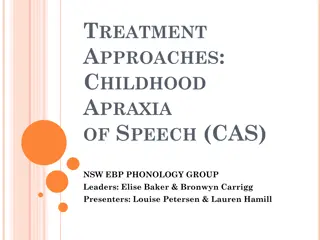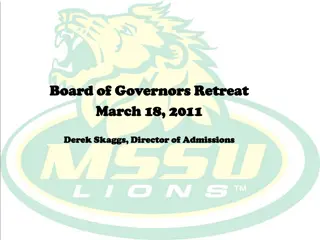EPC Presentation 2011-2015 CAS Enrollment & Student Credit Hours Overview
This presentation provides a detailed analysis of enrollment trends, student credit hour production, and the number of majors in various departments from 2011 to 2015. It covers data on undergraduate student credit hours, growth/decline in majors, and conclusions for the future. The information is presented visually in graphs and charts to offer a comprehensive overview of the academic landscape during the specified period.
Download Presentation

Please find below an Image/Link to download the presentation.
The content on the website is provided AS IS for your information and personal use only. It may not be sold, licensed, or shared on other websites without obtaining consent from the author.If you encounter any issues during the download, it is possible that the publisher has removed the file from their server.
You are allowed to download the files provided on this website for personal or commercial use, subject to the condition that they are used lawfully. All files are the property of their respective owners.
The content on the website is provided AS IS for your information and personal use only. It may not be sold, licensed, or shared on other websites without obtaining consent from the author.
E N D
Presentation Transcript
EPC Presentation 2011-2015 CAS Enrollment , SCH and SCH/FTE Overview January 18, 2016
Overview Undergraduate Student Credit Hour Production 2011-2015 Undergraduate SCH Summary by Department Number of Majors by Department 2011-2015 Growth/Decline in Majors Conclusions & the Future
Student Credit Hours 2011-15 (fall) Department Art & Design Biology CAPS Chemistry Economics English EEGS History Languages Gain/Loss Fall 11- 15 -1745 or -24% -427 or -5% -529 or -15% -195 0r -4% -213 0r -9% -2644 or -18% -875 or -19% -897or -21% -688 or -25%
Student Credit Hours 2011-15 (fall) Department Math & CS Music NAS Physics Philosophy Political Science Psychology Sociology NMU Gain/Loss Fall 11- 15 -84 or -1% -695 or -28% -213 or -15% +108 or 7% -14 or -1% -540 or -24% -976 or -20% -1045 or -20% -15599 or -13%
Student Credit Hours Summary Negative (rank order) 1. English (-2644) 2. Art & Design (-1745) 3. Sociology (-1045 4. Psychology (-976) 5. History (-879) 6. EEGS (-875) 7. Music (-695) 8. Languages (-688) Negative (rank order) 9. Political Science (-540) 10.CAPS (-529) 11. Biology (-427) 12. NAS (-213) 13. Economics (-213) 14. Chemistry (-195)
Number of Majors 2011-2015 (fall) Department Art & Design Biology CAPS Chemistry Economics English EEGS History Languages Gain/Loss (total in fall 15) -226 (532) +119 (706) -64 (224) +8 (138) -9 (34) - 86 (259) -10 (284) -57 (97) -24 (121)* incl 1stand 2ndmaj
Number of Majors 2011-2015 (fall) Department Math & CS Music NAS (minor) Physics Pre-med/dental/chiro /PA Philosophy Political Science Psychology Gain/Loss (total in fall 15) +38 (227) -7 (30) -4 (31) +4 (26) -7 (102) +2 (15) -50 (104) -94 (276)
Number of Majors 2011-2015 (fall) Department Sociology NMU Gain/Loss (total in fall 15) -26 (33) -1236 (8169)
Growth/Decline in Majors Growth rank order 1. Biology (119) 2. Math & CS (38) 3. Chemistry (8) 4. Physics (4) Decline rank order 1. Art & Design (-226) 2. Psychology (-94) 3. English (-86) 4. CAPS (-64)
Biology Growth & Decline 11-15 Growth Fisheries & Wildlife (25-105) Neuroscience (0-18) Biology (188-282) Declines Zoology (105-95) Microbiology (23-17) Physiology (122-102) Biology/Ecology (58-33)
Math & CS Growth & Decline 11-15 Growth Computer Science (94-142) Mobile and Web App (0-21) Decline Network Computing (25-12) Math Secondary Ed (44-24)
Conclusions & Discussion Arts & Sciences major counts reflect national trends: growth in STEM areas, decline in the humanities. SCH tracks major counts: biggest declines associated with humanities.
The Future: A Cautionary Note It is always wise to look ahead, but difficult to look further than you can see. Winston Churchill
The Future: Strategic Plan STRATEGIC IMPLEMENTATION Community Strategy 1:Develop programs, services, and initiatives that emphasize Northern sstrong sense of place and community. Environment Strategy 1: Emphasize the unique assets of the Upper Peninsula and its natural environment. Strategy 2: Develop programs and initiatives that expand Northern s performance as a leader in sustainability. Strategy 3:Create living, learning and teaching opportunities that expand environmentally focused academic programs and enhance individual literacy.
Discussion Which programs fit the plan?























